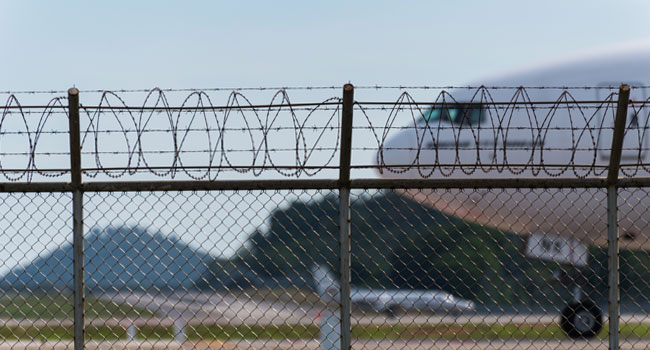
Intruder Alert
Why hi-definition and thermal network cameras are crucial for airport perimeter security
- By Anthony Incorvati
- Jan 04, 2016
Since 9/11, airport and aviation security
has generally been terminal centric
with increased checkpoint screening
for passengers and air cargo, increased
protection of the flight deck
with both physical security and air marshals to secure
planes while in flight. Given these high security
measures and what passengers experience at TSA
checkpoints and throughout terminals, it may surprise
you to learn just how vulnerable airport perimeters
may be. While there’s no question that airports
work hard to secure their perimeters, the sheer size
of some airports and the historical technology deployed
to protect them have led to some serious gaps
in airport security.
A WAKE-UP CALL: DISTURBING STATISTICS
ON PERIMETER BREACHES
The sad reality is that perimeter breaches aren’t a rare
occurrence for airports. For example, in April 2015,
there was a perimeter breach at San Jose International
Airport, their fifth occurrence in less than a year. Unfortunately,
the breach only added to the ever-growing list
of high-profile intrusions at airports around the world.
An Associated Press investigation found 268 perimeter breaches at 31 major
airports since 2004. This number represents only a fraction of the incidents because
Boston’s Logan Airport and New York City’s three major airports refused to
release any information citing security concerns. In addition, these statistics don’t
include smaller airports or those that had incomplete data.
The TSA data is even more disturbing, stating there were 1,388 breaches at 450
U.S. airports between 2001 and 2011. Collectively, this data highlights how critical
the need for accurate, dependable intrusion detection system is.
In October 2015, the Russian Metrojet 9268 tragedy in Egypt raised worldwide
awareness to the importance of tightening security measures around airport
erimeters and ramp operations.
As airports search for solutions, one tool that keeps coming to the forefront is
network video surveillance. As versatile perimeter protection systems they continually
monitor activity in and around the premises providing airports cost-effective
protection of assets, staff and passengers.
A MORE HOLISTIC APPROACH TO PERIMETER SECURITY
Video surveillance systems, on the other hand, provide a more holistic approach to
perimeter detection and verification that rarely yields false alarms. There is generally
no better way to validate a physical sensor than with an image from a camera. New,
more cost-effective thermal imaging cameras offer additional benefits for airport
perimeter environments. Automated detect-track-notify solutions, enabled by recent
advances in camera hardware and video analytics software, further improves effectiveness
by enhancing real-time situational awareness and response capability.
THE BEST OFFENSE IS AN EARLY DEFENSE
The first goal in perimeter protection is to detect a threat or an intrusion at the
earliest possible stage. One of the best early warning tools is a modern thermal
network camera. Unrivaled in detection sensitivity and accuracy, this technology
is ideal as a first line of defense. Thermal cameras do not require any light at all
to operate. They are able to spot a person or an object by the thermal radiation
they emit.
Today’s HDTV and megapixel-resolution network cameras make facial identification
or license plate recognition possible even at great distances. Special lowlight
technology that reduces noise and maintains full color fidelity even in very
dark conditions greatly enhances recognition and identification of people, vehicles
and critical incident details.
Operators can use remotely operated PTZs and well-placed fixed cameras to
track the whereabouts of intruders while guiding an employee or a guard patrol to
intercept the trespasser. The archived video of the intruder’s movements and activities
can then be used as irrefutable evidence for detention and prosecution.
TRUE OR FALSE? NOW YOU KNOW
Misinterpreting alarms raises all sorts of problems when it comes to airport perimeter
protection. With judicious use of advanced network camera surveillance,
coupling hi-definition PTZ and fixed cameras with thermal cameras and video
analytics, airports can not only detect possible intruders far earlier than before,
but can also verify the extent and severity of a breach and provide
essential situational awareness to initiate an appropriate
and effective response.
Nutkamol komolvanich / Shutterstock.com
This article originally appeared in the January 2016 issue of Security Today.
About the Author
Anthony Incorvati is the manager of business development, transportation, at Axis Communications.